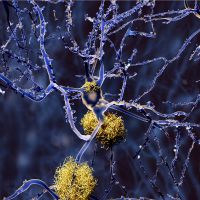Amyloid beta 42 is a protein – a natural byproduct of brain activity, normally is cleared from the brain before it can clump together into plaques that are suspected to be a key contributor to Alzheimer’s disease. Randall J. Bateman, from Washington University School of Medicine (Missouri, USA), and colleagues assessed amyloid-beta kinetics in 112 men and women, ages 60 to 87 years, half of whom had clinical signs of Alzheimer’s disease. Plaques had begun to form in the brains of 62 participants. Each subject received detailed mental and physical evaluations, including brain scans to check for the presence of plaques, and cerebrospinal fluid analysis to monitor the body’s production and clearance of amyloid beta 42 and other proteins. In patients with evidence of plaques, the researchers observed that amyloid beta 42 appears to be more likely to drop out of the fluid that bathes the brain and clump together into plaques. Reduced clearance rates of amyloid beta 42, such as those seen in older participants, were associated with clinical symptoms of Alzheimer’s disease, such as memory loss, dementia and personality changes. Reporting “a highly significant correlation between increasing age and slowed A[beta] turnover rates (2.5-fold longer half-life over five decades of age),” the study authors submit that: “These findings reveal a mechanistic link between human aging and the risk of amyloidosis, which may be owing to a dramatic slowing of A[beta] turnover, increasing the likelihood of protein misfolding that leads to deposition.”
Mechanism of Alzheimer’s Onset Revealed
Bruce W. Patterson, Donald L. Elbert, Kwasi G. Mawuenyega, Tom Kasten, Vitaliy Ovod, Randall J. Bateman, et al. “Age and amyloid effects on human central nervous system amyloid-beta kinetics.” Annals of Neurology, Volume 78, Issue 3, September 2015, Pages: 439–453,
RELATED ARTICLES




